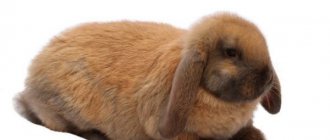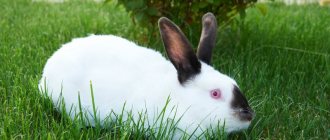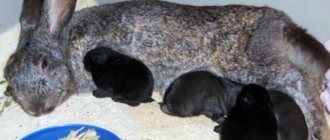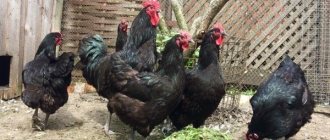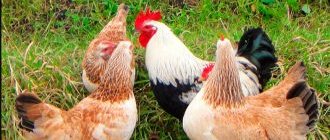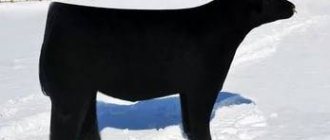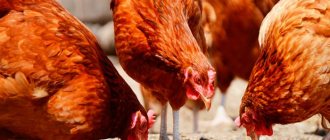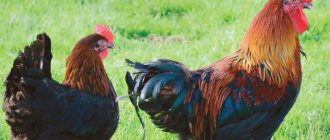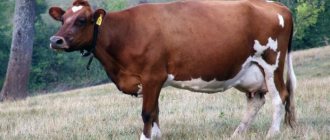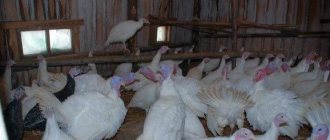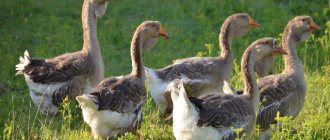Livestock » Rabbits
0
1511
Article rating
Kira Stoletova
The sheep rabbit is a meat or ornamental breed that was first bred in England. It got its name because of its hanging ears and the special structure of its muzzle. Over the past two centuries, several varieties of sheep rabbits have appeared in different countries. In our country they became famous relatively recently. Most often, lop-eared rabbits are now bred as ornamental animals.
Rabbits of the Ram breed
general information
The breed appeared at the end of the 19th century. English scientists involved in breeding work drew attention to a strange mutation in one of the rabbits. The individual had long floppy ears. This attracted breeders who began to develop a new breed. Large meat-and-skin rabbits took part in the experiments. The work culminated in the creation of a new variety of rabbits.
Note! At first glance, the animal's full face resembles that of a lamb. Wide cheeks, sloping forehead, narrowed-round eyes, a slightly humped nose, a massive torso and a fluffy warm fur coat. Because of this, the animal was called a ram. Another name for the breed is lop-eared ram.
Rabbit ram
Rabbits with long ears attracted the attention of residents of Europe and Mediterranean countries. In the 20th century, breeders from different cities were improving the variety. As a result, a whole group of sheep representatives was created, among them:
- English;
- German;
- Dwarf;
- Nappy;
- French, etc.
The English breed is the ancestor of the entire group. These animals are distinguished not only by long ears, but also by short forelimbs. The animal quickly gets used to its owner. The breed is suitable for keeping in an apartment.
The German ram rabbit is the giant of all lop-eared rams. Its average weight is 9 kg.
The dwarf representative was bred as a pet, an alternative to a cat. He has excellent body proportions and looks like a soft toy.
Raising a furry pet means keeping it in the comfort of an apartment. These domestic animals are extremely fluffy and have soft, tousled fur. They resemble dwarfs in size.
The French rabbit is the most attractive animal for aviary breeding. Meat breed. The German breed of giant rabbits was bred from the Frenchman. The Frenchies themselves also grow to impressive sizes. In addition, the animals have especially fluffy and soft skin. The French ram rabbit whose breed description includes large sizes, is valued for its very rapid weight gain. It is recommended to slaughter animals 3.5-4.5 months after birth. By this time, individuals gain decent weight. Tender meat is considered hypoallergenic. It is suitable for dietary and baby food.
Main characteristics of rabbits and rams
The sheep breed rabbit appeared as a result of a mutation that led to lop ears. Two centuries ago, British rabbit breeders decided to fix a genetic anomaly. Since that time, the feature has been persistently passed on from generation to generation. As a result, the first fold-eared breed appeared - the English Ram. The animals got their name because they look like small lambs. Today there are more than ten varieties. Each has its own characteristics, but they are all united by common characteristics:
- drooping ears
- Large head
- Broad forehead
- Short blunt nose with a hump
The sizes of the animals are different. There are giant lop-eared rabbits and dwarf rams. Young animals have straight ears; they begin to droop at the age of about 6 weeks. Ram rabbits have a calm character. Due to the special structure of their ears, they are not so sensitive to sounds and are not too shy. True, breeding a breed of rabbits and rams requires some effort.
Breed characteristics
Due to the particular popularity of breeding French sheep, the characteristics of the breed are dedicated specifically to them. These mammals are impressive in size. They gain from 4 to 11 kg of weight. Body length ranges from 50 to 70 cm. Paws are athletic and powerful. The chest is wide, slightly sunken. The back is sagging, semicircular. However, the first thing people notice when petting these pets is their protruding, chubby cheeks.
Lop-eared rabbit ram
The French ram rabbit has richness in the form of long ears. This part of the body can reach a length of 40-55 cm. For the convenience of animals, farmers sometimes tie their ears with elastic bands. Before the baby rabbit is 40-50 days old, its ears stand up or are placed in different directions, like those of ordinary representatives of the Zaitsev family.
The rabbit fur of the breed is striking in its variety of colors. The following coat colors are allowed:
- Blue;
- Motley-patterned;
- Light and dark gray;
- Chocolate;
- Snow White;
- Oil colors, etc.
The fur coat consists of thick, soft wool with undercoat.
Important! It is believed that representatives of the entire breed group are calm, phlegmatic and peace-loving animals. The main reason here is the long ears, which completely cover the auricle. Because of this, the functionality of the hearing organ is impaired. Mammals practically cannot hear. This protects them from the fears that ordinary rabbits experience from loud noises.
Females and males
Animals can be distinguished by gender based on several characteristics. But the signs are relevant only for individuals who are already 1.5 months old. Ram rabbits practically do not differ in gender.
Ram rabbits practically do not differ in gender
- By the reproductive organs that are located under the tails of animals.
- Males have a large head. Their bones are wide and heavy.
- Females look larger, rounder and more proportional. Their head is small, slightly elongated.
- Males move heavily, angularly and a little clumsily.
- Females jump and move smoothly and gracefully.
Fertility
The disadvantage of the breed is the lack of high fertility. One female rabbit brings 3-6 cubs. Sexual maturity in males occurs at 5 months, in females at 8-9 months.
Care and feeding of animals
For rabbit breeding to be successful, it is necessary to feed the animals properly. The French sheep rabbit eats 3 times a day, and it is desirable that the rabbit receives food at the same time. Thus, they begin to build muscle mass faster.
If you have lop-eared sheep rabbits, then you need to feed them the following foods:
- in the summer they provide fresh and juicy greens, cereals and fruits;
- in winter, meadow hay and cereal crops must be added to the animals’ diet;
- Vegetables are added to the rabbits' diet all year round.
At the same time, do not forget that clean and fresh water should always be in the long-eared drinkers.
French ram rabbits happily feast on almost any food that the breeder gives them. Therefore, it is very important to know what food to give to such individuals is strictly prohibited, namely:
- beans;
- cabbage and rhubarb;
- tomatoes.
These products are strictly prohibited for consumption by sheep. Moreover, the tops of such vegetables should also not be given.
How to choose a good rabbit
A decent lamb suitable for further breeding should not be suckled, that is, drink its mother's milk. The optimal age for purchase is 1.5-7 months. The fur coat should shine. The presence of adhering dirt is not allowed on it. You shouldn't buy a skinny one. The body composition should be harmonious, without protruding bones or club feet. The head of a healthy animal is usually set straight, the ears are in a hanging position.
White rabbit Pannon
A suitable individual appears calm. The behavior of a sick animal is nervous, it jumps, turns its head, and itches. The presence of injuries, baldness, and dried blood on the face is unacceptable. The nose should be dry. Wet - indicates a cold, infection or allergy. If the eyes are watery or pus is visible, it means that a member of the Zaitsev family has some kind of infection. Pus or scabs in the ears also indicate health problems.
Additional Information. The breed is kept by farmers not only to obtain dietary meat, but also for sale. Lop-eared rabbits are in demand among pet lovers. The cost of one animal ranges from 700 to 2000 rubles. The price depends on the exterior and characteristics of the baby’s parents.
Feeding schedule
Food for rabbits is usually placed in enclosures or cages three times a day. In the morning and evening, the animals are most often offered concentrates, and during the day - root vegetables. Rabbits can be given grass at every feeding. It is this diet that helps animals quickly gain body weight.
Of course, rabbits in enclosures and cages, among other things, should always have clean, fresh drinking water. Its presence should be checked and, if necessary, changed at each feeding.
Content
The largest rabbit in the world
The Lamb Rabbit, due to its powerful shape and elongated ears, requires special maintenance. Large enclosures are being prepared for them, where the individuals will be comfortable. A cage 1.2 m wide, 0.9 m high, 1.2 m long is suitable.
Note! Due to the weight of these mammals, the entire load falls on the legs. Therefore, an important condition must be observed: the floor in the pen is covered with a thick layer (7-10 cm) of bedding. Hay, sawdust, and newspapers will do. Otherwise, corns will appear on your paws.
There should be no sharp objects in the cage that could injure animals.
Several times a week, the houses are thoroughly cleaned, washed with soapy water, and dried. Enclosures should be located in a clean, insulated, ventilated yard or barn. Sheep have weak immunity, so they should not be kept in cold or drafty conditions.
Due to the weight of these mammals, the entire load falls on the legs
Small animals are separated from adults. They can be in the same cage with the mother, but separately from the males. Females and males also live separately. They are housed together only for mating.
Note! Animals love to chew wood. If there are wooden elements in the cage, then the rabbits will take care of them. To prevent this from happening, it is recommended to place willow branches in the enclosures. This is an excellent material for rabbits to sharpen their teeth.
Nutrition
A balanced diet for animals consists of:
- ü Fresh vegetables;
- ü Slightly withered grass;
- ü Zlakov;
- ü Fruit salads;
- ü Compound feed, etc.
Do not put cabbage, tomatoes, legumes or spoiled foods in the feeder. Such food will cause poisoning and diarrhea.
The peculiarity of the breed is its easy weight gain. But there is a drawback here. Animals tend to store fat. Therefore, feeding should not be abundant and rare, but frequent and moderate. Food is given in the morning, afternoon and evening. The drinking bowls should contain warm, clean water.
Health
Weak immunity fails rams. It is important for the owner of furry pets to pay attention to the prevention and treatment of diseases. To protect animals from dangerous diseases (myxomatosis and necrotizing hepatitis), vaccination is carried out. It is important to keep animals clean. They also need to be given anti-worm medications. Among these medications:
- Prazel;
- Pyrantel;
- Albendazole;
- Shustrik;
- Drontal, etc.
Fold-eared animals are susceptible to various infections. If you suspect an illness, you should contact your veterinarian. New generation antibiotics are used for treatment.
Caring for rabbits
Rabbits are fairly clean animals. Therefore, it is important to take care of periodic cleaning and disinfection of the cage.
French Lambs must be kept separately: young animals cannot be kept with adults, and males cannot be kept with females.
To keep lambs, you should purchase a large cage or a spacious enclosure, in which the pets will not cling to their ears and injure them. It is better to make cages from bars, and place a plastic tray on the floor, which is covered with straw and sawdust. Its depth should be at least 15 cm so that animals can dig freely.
You can install a house inside a large cage. The best material for its manufacture is considered to be cellular polycarbonate. It perfectly transmits sunlight and protects from drafts. Rabbits usually hide in it or place their offspring.
Animals should not be kept in cages with a metal mesh floor or a fleecy surface.
An example of organizing an enclosure for rabbits
“Cages should not be installed in areas exposed to direct sunlight.”
To ensure uniform grinding of the incisors, there should always be pieces of food chalk, twigs or slices of stale bread in the cage.
Since rabbits are quite heat-loving animals, to keep them in winter, the cages must be additionally insulated. In severe frosts, it is recommended to install heaters at some distance from the cages.
It is important to take care of pet hygiene. Regular care should include the following:
- inspection and cleaning of the ears using cotton swabs;
- trimming nails to prevent ingrown nails;
- Regular brushing of fur.
Since the animal has thick fur, it is necessary to clean it in a timely manner. It is not recommended to bathe a small animal; just wipe the dirty fur with a damp cloth.
Breeding secrets
Experienced rabbit breeders know the secrets of breeding sheep and rabbits, for example:
- Reproduction is allowed only after individuals reach maturity. Females are allowed to mate from 8-9 months of age, males - from 5-6 months.
- You cannot mix individuals of different breeds. The offspring after such experiments are born with defects in appearance.
- Only the most ideal individuals are suitable for mating.
- Obese animals should not be allowed to mate. Fold sheep whose weight does not exceed 5 kg can become parents.
- The process is organized on the territory of the male. A female rabbit is placed in his pen.
- Females are allowed to mate selectively. Only young animals aged from 9 months to 3 years can give birth to healthy offspring. After the age of three, females are prohibited from giving birth. Childbirth can cause the death of the animal and its offspring.
Breeding at home
In Russia, French sheep are bred as an ornamental animal, as well as rabbits for meat production. They are highly profitable due to their rapid maturation and weight gain.
The breed is not prolific; from one female you can get only 5-7 rabbits. Mating is possible from 6 months for males and from 9 months for females; to maintain the breed standard, some breeders try to use only breeding males.
It is not recommended to use representatives of other breeds, since in the process of inbreeding the main characteristics are lost. Mating is typical for rabbits - first the female is placed in a cage with the male, waiting for cover. Control mating is carried out after 5-7 days.
Pregnancy lasts up to 30 days . Due to anatomical features, the first birth in rabbits occurs independently; subsequently, they cannot give birth without human help. After 3 years, animals are not used for breeding, as this is dangerous to the health and life of the female.
Female rabbits of French rams are caring mothers; they rarely experience abandonment of their offspring and cases of cannibalism. Females feed the rabbits well and try to protect them.
Advantages
The fold-eared ram has a pleasant appearance
- The fold-eared ram has a pleasant appearance. He stands on a par with such beautiful rabbits as Hermelin, Lionhead, and Japanese.
- The ram is the calmest and most peaceful representative of the Zaitsev family.
- Unlike many other breeds (for example, silver rabbit, mardera, white giant, etc.), a ram can have different colors.
- The breed's coat is soft and fluffy. The wool is high quality. However, in terms of density it is inferior to the Russian Himalayan rabbit and chinchilla.
- Like the gray giant, the lop-eared ram is unpretentious in food and care.
- Unlike Flanders, Risen, Butterfly, etc., lop-eared rabbits do not eat their offspring. They conscientiously take care of newborn babies.
Historical facts about the origin of the breed
The first mention of the fold-eared breed dates back to 1850. It appeared in France as a result of crossing two breeds. The ancestors are considered to be representatives of unusual species: the Flemish giant and the English lop-eared rabbit.
In just a few years, the new breed conquered not only the entire country, but also neighboring countries: Germany, Belgium and Holland. It is these countries, due to the increased interest in this type of rabbit, that are considered the ancestors of the ram breed standard.
After the end of the war between France and Prussia, the Germans adopted the experience of breeding lop-eared rabbits and over time significantly improved the breed. After the appearance of individuals in Holland, the exotic species gradually spread across all continents of the planet. In Russia, breeding of the breed began twenty years ago.
Flaws
- Like the Viennese and New Zealand breeds, the lop-eared ram is not long-lived. It usually lives for about 7-10 years.
- Sheep have weak immunity. In this way they are similar to the black-brown rabbit and the Angora variety.
- Low fertility. A similar disadvantage exists in the Rex and Flanders breeds.
Breeding sheep and rabbits begins with the purchase of healthy individuals, the arrangement of spacious enclosures, and the preparation of a balanced diet. Caring for them is easy. The main thing is to keep the animals clean, warm, protected from diseases and fed on time. If all points of maintenance and care are carried out correctly, you can get rich with rabbits.
4 1 vote
Article rating
Characteristics and standard, features
The appearance of a French ram, according to breed standards, has the following characteristics:
- weight – 4-7 kilograms, large individuals reach 10 kilograms, males are somewhat smaller than females;
- body – elongated, 60-70 centimeters;
- fur color – different is allowed, including a combination (2-3 colors);
- the fur structure is delicate and silky, with a pronounced dense undercoat;
- the shape of the head resembles that of a lamb - with a pronounced frontal bone and shortened fur, the cheeks are plump and heavy;
- the famous ears grow to 20-40 centimeters, fall several centimeters below the rabbit’s chin, width - 10-15 centimeters;
- the hind legs are powerful and elongated, the front legs are traditionally short;
- The croup is wide and round in shape.
Information: the ears of baby rabbits fall off at the age of one and a half to two months; at birth, lop ears are invisible.
Breeders value rams for their non-conflict nature and phlegmatic nature. Defects in the auricle make rabbits deaf, so they react little to noise, do not shake from extraneous sounds, and do not fuss for no reason.
To avoid problems with reproduction in this breed, you need to monitor the diet, since the French ram is prone to obesity, and this reduces the already low fertility. Rabbits of this breed become attached to their owners, love affection, and appreciate human care and company.
